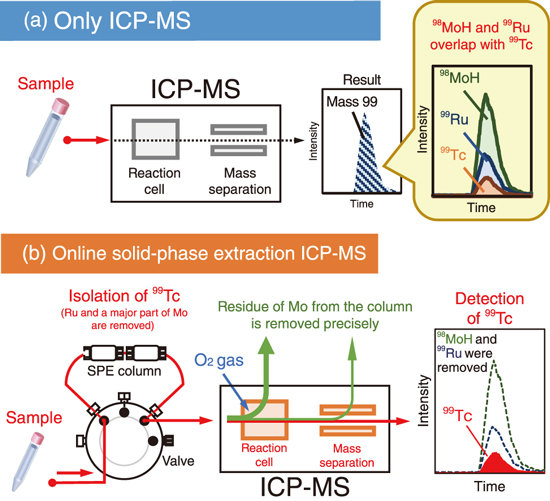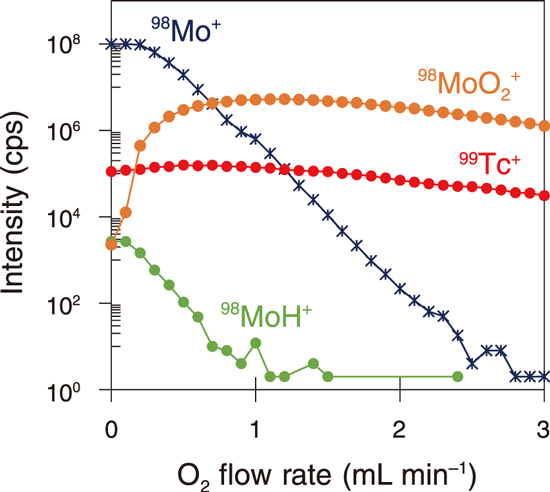
Fig.1-25 (a) Typical inductively coupled plasma–mass spectrometry (ICP-MS) analysis and (b) proposed online solid-phase extraction ICP-MS

Fig.1-26 Gas-phase reaction of oxygen and elements (98Mo and 99Tc) in the reaction cell of ICP-MS
Technetium-99 (99Tc) is an artificial radionuclide with a long half-life of 210,000 years and a pure beta emitter. 99Tc is produced as one of the fission products and in yields equal to the yields of cesium-137 and strontium-90 (approximately 6%) from nuclear material such as uranium-235. Specific seaweeds accumulate 99Tc, although they transport it widely in the marine environment. The concentration of 99Tc in seaweeds and the annual discharge amounts in nuclear-reprocessing plants in foreign countries were reported to have a reasonable correlation. Similarly, it is expected that 99Tc will become one of the important tracers for monitoring the transport of radionuclides around the sea in Japan. However, there is no official analytical method for 99Tc in Japan. In this study, we developed an analytical method to understand 99Tc transport in the environment.
The radioanalytical method used for 99Tc (beta counting) needs the separation of all other beta nuclides–this pretreatment process is complicated and time-consuming. The analysis is concentrated on a large sample volume to detect an ultratrace level of 99Tc because of the low sensitivity compared with mass spectrometry. In this study, an analytical method using inductively coupled plasma–mass spectrometry (ICP-MS) to measure 99Tc with a small sample volume was developed. ICP-MS enables rapid and highly sensitive determination of specific mass numbers (in this case, mass number 99 is selected). However, the quantification of 99Tc with typical ICP-MS analysis is prevented by coexisting signal-overlapping materials, namely, ruthenium-99 (99Ru) and 98MoH (created from molybdenum-98 (98Mo) and hydrogen in the equipment), which have the same mass number as 99Tc (Fig.1-25(a)). Therefore, we developed an analytical system equipped with multistage separation with a solid-phase extraction (SPE) column packed with a selective adsorption resin for 99Tc, and we adopted a gas-phase reaction with oxygen in the reaction cell of ICP-MS for the effective separation of the interfering materials (Fig.1-25(b)). The SPE column eliminated 99Ru and 98Mo, and their concentrations decreased to values lower than 1/4000 and 1/3000, respectively. However, the concentrations of 99Ru and 98Mo are 400 times and 1.6 billion times higher than that of 99Tc in the Japan Sea. Thus, the required removal rate of 98Mo was not achieved. Then, the gas-phase reaction with oxygen in the reaction cell of ICP-MS discriminated precisely between 99Tc and 98Mo by converting 98Mo and 98MoH to 98MoO2 (mass number: 130) via an oxidative reaction, while 99Tc remained nonreactive (Fig.1-26). The synergistic effect of SPE and gas-phase reaction enables analysis of samples containing high concentration of 98Mo, which has a concentration a trillion higher than that of 99Tc.
We performed measurements for a seawater reference material (certified value: 159-250 mBq/L) using this proposed method, and the obtained values (200.1 ± 9.6 mBq/L) were in agreement with those of the reference material. The online SPE ICP-MS contributes to wide-area research of 99Tc in the environment owing to the high-throughput analysis (analytical time: within 30 min per sample).
(Makoto Matsueda)